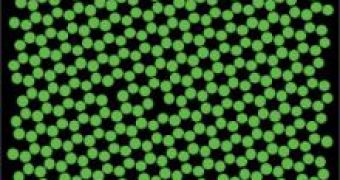When you are dealing with incredibly tiny things it is rather difficult to organize them in the exact patterns you desire. A nano-particle is something having the size of around one millionth of a millimeter. What do you do when you have a vial full of such tiny particles and you want to use them for constructing some larger structure with a definite pattern?
This entire endeavor is based on a phenomenon dubbed "self-assembly": when a large group of particles are subjected to certain external conditions they spontaneously assemble themselves into a certain structure. This phenomenon is basically identical to the phenomenon of freezing (of solidification). When you cool the water under various conditions you get various types of ice, having various internal structures; think about the proverbial variety of snowflakes. The problem, however, is to get a certain specific structure that one desires. Insofar, nanotechnologists used the trial-and-error strategy. They simply set some conditions more or less at random and then observed what happened. This is approximately the same type of strategy nature uses when it builds complex structures without a predetermined plan.
A Princeton group decided to turn the problem on its head: start with the desired pattern and deduce what conditions should be imposed.
''If one thinks of a nanomaterial as a house, our approach enables a scientist to act as architect, contractor, and day laborer all wrapped up in one," Salvatore Torquato, one of the authors of the study, said. "We design the components of the house, such as the 2-by-4s and cement blocks, so that they will interact with each other in such a way that when you throw them together randomly they self-assemble into the desired house." "To do the same thing using current techniques, by contrast, a scientist would have to conduct endless experiments to come up with the same house. And in the end that researcher may not end up with a house at all but rather - metaphorically speaking - with a garage or a horse stable or a grain silo," Teresa Riordan remarked.
The way Torquato et. al. managed to solve the problem was by using statistical mechanics. Statistical mechanics is designed to make predictions about the macroscopic features of a system when one knows (or creates a model of) the microscopic structure of the system. Insofar, statistical mechanics has been used to compute the macroscopic properties of existing, already synthesized, systems. Now it has been used to decide what macroscopic conditions should be imposed in order to synthesize a certain desired system. A similar technique already exists in chemistry, called QSPR/QSAR. This technique is used to theoretically estimate the properties of certain yet unsynthesized molecules. The point is that instead of synthesizing hundreds of molecules, analyzing them and then selecting the desired ones, one tries to filter the candidate molecules theoretically and then synthesize only the most promising ones.
Torquato et. al. paper thus represents the first step towards a similar approach in the field of nano-technology.
Reference: Optimized Interactions for Targeted Self-Assembly: Application to a Honeycomb Lattice Mikael C. Rechtsman, Frank H. Stillinger, and Salvatore Torquato Phys. Rev. Lett. 95, 228301 (2005)

 14 DAY TRIAL //
14 DAY TRIAL //